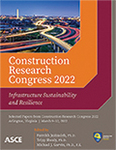Disasters as Mega-Disruptions to Construction Supply Chains
Publication: Construction Research Congress 2022
ABSTRACT
Natural hazard disaster events such as hurricanes are increasing in frequency and intensity across US coastal states and territories, serving as mega-disruptions of residential construction industry labor and material supply chains. Hurricanes create sudden competition for the limited post-disaster residential construction resources available within the construction supply chain, affecting labor wages and material prices. However, few quantitative studies have examined how disaster mega-disruptions affect post-disaster construction supply chains. Utilizing supply chain management theory and data from the 2017–2018 US hurricane season, this study addresses the question: How do disaster mega-disruptions influence post-disaster residential construction labor and material supply chains? Specifically, this study assesses how Hurricanes Harvey, Maria, Irma, and Florence collectively served as a supply chain mega-disruption by causing billions in residential housing damages across Texas, Florida, North Carolina, and Puerto Rico from 2017 to 2018. First, data from the Federal Emergency Management Agency (FEMA) were used to measure housing damages caused by the mega-disruption in the four hurricane affected states and territories. Second, increased post-disaster demand for construction was calculated by comparing disaster damages against the volume of housing typically built by the residential construction industry according to the US Census. Finally, data from the Bureau of Labor Statistics (BLS) were utilized to measure how hurricane housing damages affected residential contractor labor wages and building material prices. Results indicate that the 2017–2018 hurricanes generated pricing surges, creating a mega-disruption to both residential construction labor and material supply chains.
Get full access to this article
View all available purchase options and get full access to this chapter.
REFERENCES
Arneson, E. (2019). “How Residential Roofing Resource Availability Affects Post-Disaster Reconstruction.” Proceedings of the ASC International Proceedings of the Annual Conference 2019, Associated Schools of Construction, Denver, CO.
Arneson, E., Javernick-Will, A., Hallowell, M., and Corotis, R. (2020). “Predicting Postdisaster Residential Housing Reconstruction Based on Market Resources.” Natural Hazards Review, 21(1), 04019010.
BLS. (2021a). PPI Commodity data for Net inputs to residential construction, goods, not seasonally adjusted., Bureau of Labor Statistics (BLS), Washington, D.C.
BLS. (2021b). Private, NAICS 2361 Residential Building Construction, All States and U.S., U.S. Bureau of Labor Statistics (BLS), Washington, D.C.
Cheshmberah, M., and Beheshtikia, S. (2020). “Supply Chain Management Maturity: An All- Encompasing Literature Review on Models, Dimensions and Approaches.” Scientific Journal of Logistics, 16(1), 103–116.
Ellingwood, B. R., Rosowsky, D. V., Li, Y., and Kim, J. H. (2004). “Fragility Assessment of Light-Frame Wood Construction Subjected to Wind and Earthquake Hazards.” Journal of Structural Engineering, 130(12), 1921–1930.
FEMA. (2018). 2017 Hurricane Season FEMA After-Action Report. Federal Emergency Management Agency (FEMA), Washington, D.C., 65.
FEMA. (2020). OpenFEMA Dataset: Individual Assistance Housing Registrants - Large Disasters. API Endpoint, Federal Emergency Management Agency (FEMA), Washington, D.C.
Harland, C. (2021). “Discontinuous Wefts: Weaving a More Interconnected Supply Chain Management Tapestry.” Journal of Supply Chain Management, 57(1), 27–40.
Hoglund, L., Pollock, J., and Weinhagen, J. C. (2015). New PPI net inputs to industry indexes. Bureau of Labor Statistics (BLS), Washington, D.C.
Kalaitzi, D., Matopoulos, A., Fornasiero, R., Sardesai, S., Barros, A. C., Balech, S., and Muerza, V. (2021). “Megatrends and Trends Shaping Supply Chain Innovation.” Next Generation Supply Chains, Lecture Notes in Management and Industrial Engineering, R. Fornasiero, S. Sardesai, A. C. Barros, and A. Matopoulos, eds., Springer International Publishing, Cham, 3–34.
Marshall, T. P. (2014). “Tornado Damage, Survey at Moore, Oklahoma.” Weather and Forecasting, 17(3), 582–598.
NOAA. (2018). Billion-Dollar Weather and Climate Disasters: Overview. National Oceanic and Atmospheric Administration (NOAA), Washington, D.C.
Pradhan, S., and Arneson, E. (2021). “Postdisaster Labor-Demand Surge in the US Highways, Roads, and Bridges Construction Sector.” Journal of Management in Engineering, 37(1), 04020102.
Sodhi, M. S., and Tang, C. S. (2021). “Supply Chain Management for Extreme Conditions: Research Opportunities.” Journal of Supply Chain Management, 57(1), 7–16.
U.S. Census Bureau. (2017). New Privately Owned Housing Units Authorized Valuation for Regions, Divisions, and States. Permits by State, Washington, D.C.
U.S. Census Bureau. (2021). Value of Privately Owned Housing Units Authorized by Permits. Building Permits Survey, U.S. Census Bureau, Washington, D.C.
WEF (World Economic Forum). (2012). New Models Addressing Supply Chain Transport Risk. World Economic Forum (WEF), Switzerland.
Information & Authors
Information
Published In
History
Published online: Mar 7, 2022
Authors
Metrics & Citations
Metrics
Citations
Download citation
If you have the appropriate software installed, you can download article citation data to the citation manager of your choice. Simply select your manager software from the list below and click Download.
